
A blood sausage is a sausage filled with blood that is cooked or dried and mixed with a filler until it is thick enough to solidify when cooled. Most commonly, the blood of pigs, sheep, lamb, cow, chicken, or goose is used.
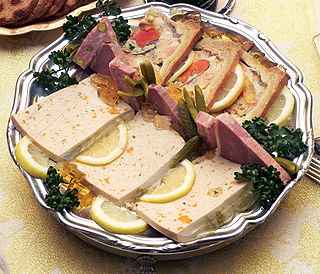
Offal, also called variety meats, pluck or organ meats, is the internal organs of a butchered animal. The word does not refer to a particular list of edible organs, and these lists of organs vary with culture and region, but usually exclude skeletal muscle. Offal may also refer to the by-products of milled grains, such as corn or wheat.
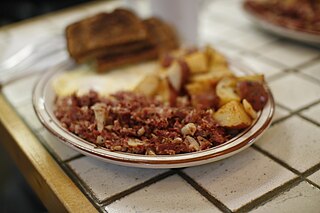
Hash is a dish consisting of chopped meat, potatoes, and fried onions. The name is derived from French: hacher, meaning 'to chop'. It originated as a way to use up leftovers. In the U.S. by the 1860s, a cheap restaurant was called a "hash house" or "hashery."
Maltese cuisine reflects Maltese history; it shows strong Italian influences as well as influences from Spanish, French, Provençal, and other Mediterranean cuisines, with some later British culinary influence. Having to import most of its foodstuffs, being positioned along important trade routes, and having to cater for the resident foreign powers who ruled the islands opened Maltese cuisine to outside influences. The traditional Maltese stewed rabbit is often identified as the national dish.

The oldest known book on Portuguese cuisine, entitled Livro de Cozinha da Infanta D. Maria de Portugal, from the 16th century, describes many popular dishes of meat, fish, poultry and others.
Sweet and sour is a generic term that encompasses many styles of sauce, cuisine, and cooking methods. It is commonly used in East Asia and Southeast Asia and has been used in England since the Middle Ages. Sweet and sour sauce remains popular in Asian and Western cuisines.
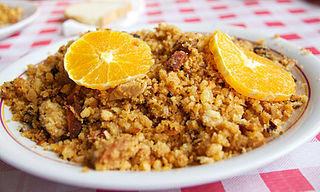
Migas is a dish traditionally made from stale bread and other ingredients in Spanish and Portuguese cuisines. Originally introduced by shepherds, migas are very popular across the Iberian Peninsula, and are the typical breakfast of hunters at monterías in southern Spain.

Francesinha is a Portuguese sandwich, originally from Porto, made with layers of toasted bread and assorted hot meats such as roast, steak, wet-cured ham, linguiça, or chipolata over which sliced cheese is melted by the ladling of a near-boiling tomato-and-beer sauce called molho de francesinha. It is typically served with french fries.
The tendons of certain animals are used as an ingredient in some Asian cuisines, including the Filipino, Chinese, Japanese, Korean, Indonesian, Thai, Laotian, Cambodian and Vietnamese traditions. Tendon is tough and fibrous, but becomes soft after a long period of cooking. In some cases it may be boiled for as long as eight hours, while in other dishes it is prepared by deep frying. It contains large amounts of collagen, and after boiling or stewing, it is sometimes described as mimicking the mouthfeel of high-fat cuts of beef despite its low fat content. One author described the taste of deep-fried tendon as being similar to chicharrón.
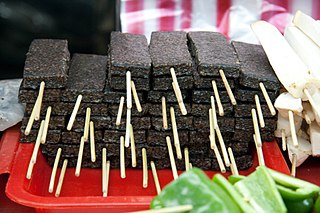
Blood as food is the usage of blood in food, religiously and culturally. Many cultures consume blood, often in combination with meat. The blood may be in the form of blood sausage, as a thickener for sauces, a cured salted form for times of food scarcity, or in a blood soup. This is a product from domesticated animals, obtained at a place and time where the blood can run into a container and be swiftly consumed or processed. In many cultures, the animal is slaughtered. In some cultures, blood is a taboo food.

Chicken parmesan or chicken parmigiana is a dish that consists of breaded chicken breast covered in tomato sauce and mozzarella, Parmesan or provolone. Ham or bacon is sometimes added.

Bermudian cuisine blends British and Portuguese cuisine with preparations of local seafood species, particularly wahoo and rockfish. Traditional dishes include codfish and potatoes served either with an add-on of hard-boiled egg and butter or olive oil sauce with a banana or in the Portuguese style with tomato-onion sauce, peas and rice. Hoppin' John, pawpaw casserole and fish chowder are also specialties of Bermuda. As most ingredients used in Bermuda's cuisine are imported, local dishes are offered with a global blend, with fish as the major ingredient, in any food eaten at any time.
Ohn no khao swè is a Burmese dish consisting of wheat noodles in a curried chicken and coconut milk broth thickened with gram flour. It features wheat noodles in a rich broth made with curried chicken and coconut milk, thickened with gram flour. Crispy fried bean fritters, hard-boiled eggs, sliced raw onions, chili peppers, and crispy noodles are added to the dish. Fish sauce and lime or lemon juice are then drizzled over everything.
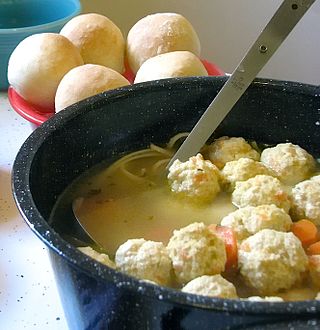
A meatball is ground meat (mince) rolled into a ball, sometimes along with other ingredients, such as bread crumbs, minced onion, eggs, butter, and seasoning. Meatballs are cooked by frying, baking, steaming, or braising in sauce. There are many types of meatballs using different types of meats and spices. The term is sometimes extended to meatless versions based on legumes, vegetables, mushrooms, fish or other seafood.

Breaded cutlet or braised cutlet is a dish made from coating a cutlet of meat with breading or batter and either frying or baking it.

Phuket cuisine originates from Phuket, Thailand and has Chinese, Malaysian, and Thai influences.

Australian Chinese cuisine is a style of cooking developed by Australians of Chinese descent, who adapted dishes to satisfy local Anglo-Celtic tastes. Its roots can be traced to indentured Chinese who were brought to work as cooks in country pubs and sheep stations.













